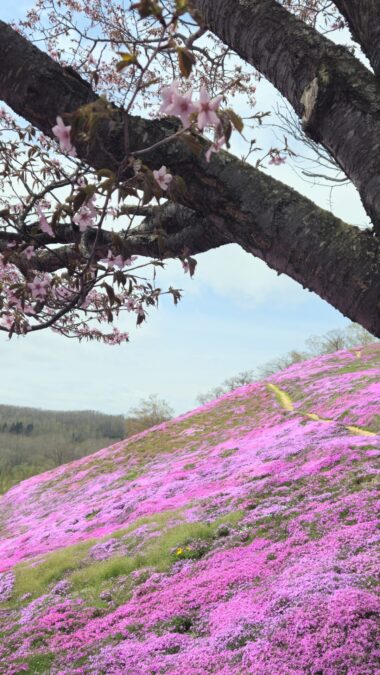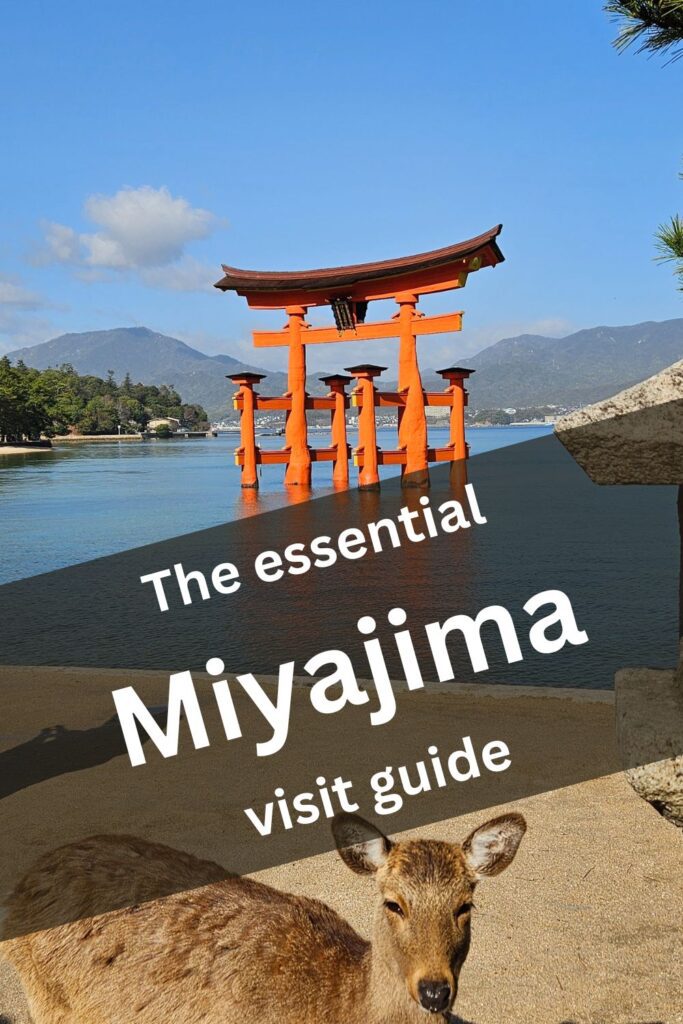Springtime in Japan is often synonymous with the enchanting burst of cherry blossoms (Sakura), painting the landscapes in gentle shades of pink and white.
The flocks of people, both visitors and locals alike, who wander around Japan during Sakura season often find small patches of beautiful pink and purple flowers on the side of the roads while on their way to the show-stealing main attractions of cherry trees in shrines, temples, and parks.
These little, five-petaled bright flowers are the “Shibazakura,” literally meaning “lawn cherry,” and known in the West as moss phlox.
They are not endemic to Japan and were introduced in the early 20th century, but leave it to our Nipponic friends to take a little unassuming flower and build breathtaking gardens that can stir the soul and overwhelm the senses.
In fact, moss phlox flowers clusters together to form dense, vibrantly colored patches, but Shibazakura parks and festivals take this to the next level, with entire fields covered in pure white, soft pink, vibrant magenta, and even purplish-blue hues, which create awe-inspiring vistas.
Witnessing a Shibazakura festival is a sensory overload, with colors that simply saturate the brain while it tries to comprehend why, all of a sudden, the world has turned pink.
When can these spectacles be seen?

Shibazakura flower later than cherry trees, with full bloom usually during the first two weeks of May. These flowers are hardier than Sakura, so the blossoming lasts longer, up to several weeks. As with cherry trees, there is almost a full-month difference between the southern part of the country (from the end of April to mid-May) compared to the northern regions (between May and June).
Peak time for visiting these gardens (as with any other major attraction in the country during spring) is during Japan Golden Week, a week between April 29 and May 5, which contains multiple public holidays. Unless you want to be immersed in joyous festive crowds, try to avoid this “Haru no Ōgata Renkyū” (long spring holiday series).
In general, given the popularity of these parks, the best time to visit is during the weekdays and (relatively) early in the morning when the crowds are sparse.
Fuji Shibazakura Festival at Lake Motosu
富士芝桜まつり
The most famous Shibazakura festival is arguably the one at Lake Motosu. This lake is part of Fujigoko, one of the Fuji Five Lakes, and it already boasts an impressive, picture-perfect view of Mount Fuji. This is already an almost humbling sight, but when coupled with a pink field that extends into the horizon, the scenery becomes absolutely breathtaking.
At the Motosuko Shibazakura Festival, the floral carpets are meticulously arranged to create intricate patterns and various shades, forming stunning mosaics visible from different viewpoints and creating a mesmerizing spectacle.
Walking paths allow visitors to meander through the fields, offering countless photographic opportunities, each more picturesque than the last.
Elevated platforms strategically placed across the site provide panoramic views encompassing both the flower fields and Mount Fuji, making for unforgettable snapshots.
Getting there
The Motosuko Shibazakura festival is by no means a hidden gem, but it can be harder to reach for visitors accustomed to traveling everywhere on a 30-minute ride on a Shinkansen (bullet train).
From Tokyo, the JR Chuo Line Limited Express takes you to Otsuki station, where the local train on the Fujikyu railway takes you to the central station of Kawaguchiko, the most famous of the Fuji Five Lakes. In Kawaguchiko, three sightseeing bus lines run to other lakes, with the blue line stopping at the smaller lakes Sai and Shoji (both beautiful stops for some peaceful enjoyment of views of Mount Fuji) and ending at Motosu.
Driving there is actually easier, being only a 2.5-hour journey from central Tokyo. I traveled both ways and definitely recommend driving, as you can experience the wonderful area of Fujigoko and enjoy the other lakes (also because the buses are often fully booked).
This way, you can also stay in the lesser-known and more intimate Ryokans (traditional Japanese hot spring resorts) rather than the obvious ones in Kawaguchiko.
What to do

The main attraction is simply walking along the many paths and taking in the beauty of the scenery while stopping at every step to take yet another wonderful photo.
However, at Lake Motosu, there are also other activities that can be done, such as taking a boat ride or enjoying waterside picnics, with the ever-present Mount Fuji in the backdrop.
The Fuji Shibazakura Resort itself also has great restaurants and an on-site microbrewery. Even simply stopping for some cake and tea in the cafe at the center of the park in the “Peter Rabbit Garden” is an overload of cuteness and spring-time bliss.
It also wouldn’t be a spring festival without the several food stalls serving iconic street food such as yakitori (grilled chicken skewers), yaki-soba (fried noodles), or the on-the-me sakura mochi (rice cakes with cherry blossom flavoring).
Outside Motosuko, the Fujigoko region is packed with sights and activities, from water sports and peaceful walks around lake Kawaguchi, fishing and canoeing in the more tranquil lakes Sai and Shoji, and visiting the ultra-famous Arakura Sengen Shrine at Kawaguchi, which hosts the Chureito Pagoda, one of the most iconic and photographed structures in Japan.
Another sight that, depending on your passions, can be breathtaking is visiting the Aokigahara Forest. Known as the Sea of Trees, this dense and mysterious forest with ancient supernatural legends and unfortunately infamous links offers a rare hiking experience. The forest is dotted with underground caves that can be visited, and it stands over lavic rocks from the last eruption of Mount Fuji. This creates a surreal, silent atmosphere where the porous rocks and the dense forest canopy muffle every sound, creating an almost eerie atmosphere that certainly adds to the mistique of the ancient forest.
Finally, as with other mountain areas of the country, the region is famous for its Onsens (hot springs) and Ryokans (traditional Japanese inns), allowing relaxation in spa resorts that combine luxury and traditional life.
Higashimokoto Shibazakura Park
東藻琴 芝桜 パ

In contrast to the southern charm of Lake Motosu, Higashimokoto Shibazakura Park in northern Hokkaido offers a less-commercialized, more tranquil escape that provides an equally awe-inspiring floral display.
In fact, the park has the largest area of planted moss in Japan, and its peculiarity is the tall, rolling hill covered in creeping moss phlox flowers of various colors, with the backdrop of a blue sky when viewed from below.
Like Motosuko, Higashimokoto Park offers numerous side paths and secluded spots, but it encourages more exploration and almost begs its visitors to explore all of the trails, stop and sit everywhere, and see the multiple viewing spots that provide different angles and photo opportunities.
Getting there
Higashimokoto Park stands way up north near Abashiri, in the town of Ozora. Reaching it is also not direct by train, as it requires a 30-minute drive or taxi ride from Abashiri Station or a bus from Abashiri Station to the town of Higashimokoto and then a 10-minute drive. Much like Motosuko, renting a car is the easiest option here, especially if you plan to then head north to Shiretoko National Park. The nearest airport is Memanbetsu, which has connections to all major cities and obviously has car rental agencies.
What to do

In the park, there are sightseeing carts and buses that offer slow transport up the winding road of the hill, allowing you to traverse the area and admire the scenery from multiple angles.
At the base of the hill, there is a small go-kart ring useful for entertaining children, and there is also a very small fishing pond, enjoyed by children and adults alike.
The main sight of the park is the pink Torii gate over the staircase that leads up the hill. This is very much an aesthetic element, and locals do not bow in front of it as would be done when entering the grounds of a Shinto shrine. There is, however, a small shrine on the top of the hill that is treated as sacred but is also popular among tourists for the tradition of ringing the Shibazakura bell for good luck.
Given the vastly different northern region of Hokkaido and its reputation for excellent food, food stalls at Higashimokoto put their regional twist on the festival fare. Food-wise, focus is given to dairy products and exceptional seafood, so visitors can enjoy fresh crab, scallops, and octopus, as well as delightful dairy treats like ice cream and cheese.
Outside the park itself, the town of Abashiri has a pretty zoo with a large variety of animals, as well as the Prison Museum and Drift Ice Museum.
The main strength of Hokkaido, however, is its natural beauty, and the region is a hiking enthusiast’s dream. The Shiretoko Peninsula, for example, is a UNESCO World Heritage Site, offering incredible wildlife and serene landscapes. Whether it is a hike on Mount Rausu, walking the many trails of the National Park and lake and spotting wild deer and Japanese bears, or simply strolling through the seaside town of Utoro and seeing Godzilla Rock, the Shiretoko National Park is packed with beautiful and serene landscapes. Hokkaido is also a region known for its Onsens, so there is no shortage of relaxing experiences nearby, blending luxury with natural beauty.
Photography tips and etiquette

You will be surrounded by the notorious (and almost unsettling) silence of Japan, even when there are large crowds. The only thing you will hear are the dozens of click sounds coming from smartphones (as Japanese smartphones are required to make a shutter sound when taking pictures even when the phones are silent).
Since the main attraction is the landscape, you will also undoubtedly take tons of photos, so prepare with ample memory and battery life.
In Japan, queues rule supreme, so the many photo spots will have (often long) queues in front of them. Obviously, do not skip the queue, and try to keep your photoshoot session short, so to leave the place for other people.
More professional photo equipment, such as tripods, can also be brought to the parks. Drones are allowed, but drone usage in Japan is more restricted than in many other countries (requiring permits, IR tracking, and weight limits), so check the guidelines carefully in advance if you’re considering taking footage with drones.
Closing thoughts
While cherry blossoms have their undisputed, show-stealing charm, Shibazakura delivers an equally stunning, yet unique, floral experience.
Even at famous Sakura spots, you can taste exquisite street food. Also there you will empty your camera memory card, taking uncountable pictures of beautiful, ephemeral flowers. Also there, you will feel the joy of people as they admire springtime bursting through the year, with nature forefully yet gracefully exploding everywhere you look.
But a Shibazakura festival is a unique experience that spellbinds you and offers a vibrant testament to Japan’s natural allure and cultural depth which deserves to be celebrated and witnessed first-hand.
In short, they are a must-see and will easily become the highlight of your trip. Nowhere else will you be able to say that you have sailed through oceans of magenta and blue.






